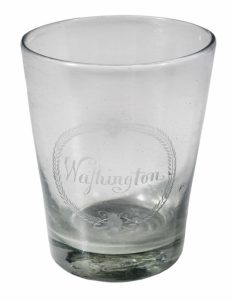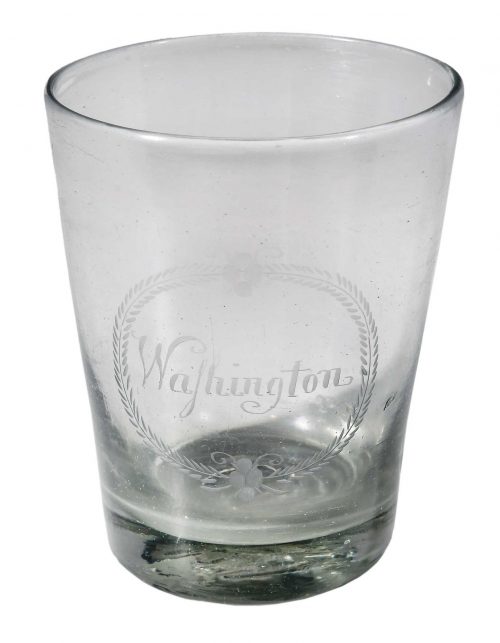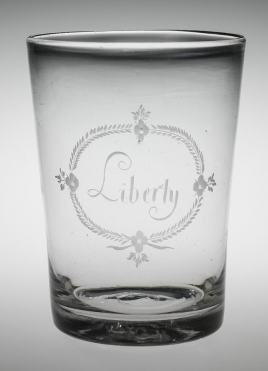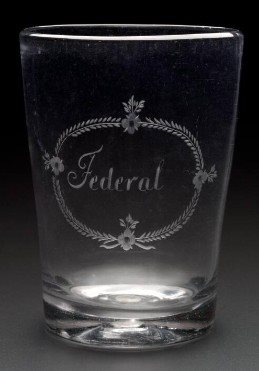An Important Amelung Discovery: The Washington Tumbler | May 19, 2023
An Important Amelung Discovery
It is a rare event when an unrecorded glass made at the New Bremen Glassmanufactory of John Frederick Amelung is discovered. Not only that, but it is a glass bearing the most famous American name of the 18th century: “Washington.” [Please note: my remarks, following, are based entirely on studying photographs of the tumbler. I have not seen it in person. However, there are no details that I can see that would suggest that it is not authentically of Amelung manufacture.]


John Frederick Amelung
John Frederick Amelung (1741-1798), the second son of farming parents, managed a farm near Bremen in Germany, but when his brother, Anton, leased the Duke of Brunswick’s mirror manufactory in Grünenplan near Hannover in Germany in 1773, he joined him as technical director. (When, where, and how he received that training is unknown.) He remained there until 1784 when, undoubtedly responding to the call for new domestic manufacturing in America following the end of the Revolutionary War, he emigrated to Baltimore, Maryland, with a large crew of workmen including glassblowers from Bohemia, Thuringia, and other parts of Germany, along with equipment for “three different Glass Ovens.” In all, 69 people made the voyage to Baltimore. He arrived with several letters of introduction from notable Americans, including Benjamin Franklin and John Adams. He quickly acquired an existing glass factory and land near Frederick, Maryland, and by 1785 had agents selling his glass in New York, Baltimore, and Philadelphia. By 1795, he had operated four glasshouses and was supporting a community of between 400 and 500 people living in the manufacturing and residential complex he named “New Bremen” (after the German city of the backers who had helped finance the operation).
Amelung advertised in 1789 that he made “all Kinds of Flint-Glass, such as Decanters, and Wine Glasses, and Tumblers of all Sizes and any other Sort of Table Glass. – He also cuts Devices, Cyphers, Coats of Arms, or any other Fancy Figures on Glass….” He demonstrated his accomplishment at least a year earlier, when he sent an engraved covered goblet to his backers in Bremen, presumably to prove his claims. It bears the coat of arms of Bremen and is inscribed “Old Bremen Success and the New Progress” and “New Bremen Glassmanufactory. 1788 / North America State of Maryland.” [Collection of the Metropolitan Museum of Art, acc. no. 28.52 A,B)] This was followed by many more engraved goblets and tumblers made for influential politicians, merchants, a glass manufacturer, and family members. Undoubtedly the most prominent of these presentations was a pair of goblets “exhibiting the General’s coat of arms, &c.” which he presented to George Washington at Mount Vernon in 1789. (Unfortunately, these goblets apparently have not survived.)
Facing severe financial pressures, he sought governmental assistance as early as 1787. One of the glasshouses burned in 1790, and he sought further aid from the Federal government. By then he is said to have invested some £20,000. His plea for funding was denied, but he continued to make presentation goblets, including one for Pennsylvania Governor General Thomas Mifflin in 1791 and a tumbler bearing the coat of arms of the United States in 1792. His debts increased, and he mortgaged his property in 1794, when he suffered a stroke. His son and a partner tried to maintain the operation, but in March 1795 the factory was advertised for sale, and in 1796 the managing partners were insolvent. Amelung died on November 21, 1798.
The Washington Tumbler
To date, there are six known engraved tumblers and goblets bearing the name of the New Bremen Glassmanufactory and dated between 1788 and 1792 – the most elaborate and the only known signed examples of American glass dating from the 18th century. In addition, there are three known pieces engraved for Amelung family members. In addition, there are some 40 or 50 engraved pieces that are firmly attributed to the factory. These examples firmly establish the vessel forms and styles of engraving that are Amelung hallmarks.
The “Washington” tumbler is consistent within the parameters established by this corpus of documented and attributed Amelung glass. Its style of lettering, called “Round Hand” in the 18th century, is consistent with other examples. The form of the “g” is essentially identical to that on the “C. Amelung / Metha Repold” goblet which is dated 1792. The style of the other letters is also consistent with other pieces.
The “wreath” surrounding the name is also a decorative device found frequently on Amelung glass. It is essentially identical to that on twelve other pieces. Especially closely related are two tumblers, one inscribed “Liberty” (Corning Museum of Glass, 79.4.333, gift of Jerome Strauss); the other inscribed “Federal” (Bayou Bend, Museum of Fine Arts, Houston, B.99.2020). The wreaths on those tumblers are interrupted by stylized four-petal flowers. Those tumblers have four flowers each on the wreath, whereas the “Washington” tumbler has two. The “antenna-like” curls above the flowers on the “Washington tumbler” are also different (and are, apparently unique on this tumbler).
The immediate inclination, upon seeing the name “Washington” on the tumbler, is to associate it with the pair of goblets known to have been presented to him in 1789. But if it was inscribed for him, it would be unique among all the known surviving Amelung glasses bearing personal names, ALL of which have either first names or initials. There are none that simply have a surname. This casts serious doubt on associating it directly with ownership by the former President. So, what other possibility might there be?


When the “Liberty” and “Federal” tumblers were discussed in the 1990 book by Lanmon and Palmer (pages 94-97 / see References), the inscriptions were interpreted as celebratory of the ratification of the Constitution in 1788, but there is another possible interpretation of the three glasses. They may have been made as gifts to Masonic lodges bearing those names. Larry Jessen, an Amelung glass scholar, has been researching that possibility. He has found that a Federal Lodge was charted in 1793 in the District of Columbia, and a Washington Lodge was in Baltimore at least by 1794. This, to me, is a more likely association. Like the signed presentation goblets and tumblers, these three tumblers would likely have been meant as potent advertising to influential Masonic members.
Finally, the form of the “Washington” tumbler – very thick base with rough pontil mark, straight sides, and slightly grayish tint to the glass – is consistent with all the other known Amelung pieces. In size, it is slightly smaller than the “Liberty” and “Federal” tumblers (5 inches vs. approximately 6 inches in height), but it is the same size as the smaller “WAG” tumbler (The National Museum of American History, Smithsonian Institution, CE.76.108). Furthermore, the wear found on the bottom and on the upper rim is consistent with what is expected and does not appear to have been “induced.”
Conclusion
I have no qualm attributing the “Washington” tumbler to the New Bremen Glassmanufactory of John Frederick Amelung. I hope it finds a good home where it will be appreciated – and, hopefully, publicly exhibited!
-Dwight P. Lanmon
Former Director, The Corning Museum of Glass
Director Emeritus, Winterthur Museum
Co-author (with Arlene Palmer) of “John Frederick Amelung and the New Bremen Glassmanufactory”
References:
Lanmon, Dwight P., and Arlene Palmer, “John Frederick Amelung and the New Bremen Glassmanufactory,” in John Frederick Amelung, Early American Glassmaker. Corning: The Corning Museum of Glass Press, and London and Toronto: Associated University Presses, 1990, pp. 11-144.
Lanmon, Dwight P., and Arlene Palmer, “John Frederick Amelung and the New Bremen Glassmanufactory,” Journal of Glass Studies (XVIII, 1976), pp. 14-136.
Palmer, Arlene, Glass in Early America. Winterthur, DE: Henry Francis du Pont Winterthur Museum, 1993, pp. 10, 70-71, 94-98, 198-199, 261, 365.
For two closely related examples, see: Lanmon and Palmer, “John Frederick Amelung and the New Bremen Glassmanufactory,” in John Frederick Amelung, Early American Glassmaker. Corning: The Corning Museum of Glass Press, and London and Toronto: Associated University Presses, 1990, pp. 94-97. The “Liberty” tumbler (Corning Museum of Glass, 79.4.333) and the “Federal” tumbler (Bayou Bend, Museum of Fine Arts, Houston, B.99.2020).
World-Class Consignments and Exceptional Results